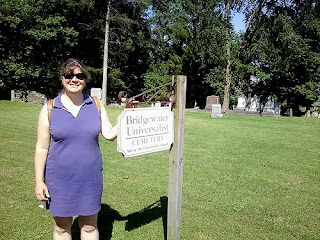Because these were the early days of the internet, online information about small towns was scarce. Bridgewater State College had its own web site, of course (at the forever-truncated bridgew.edu, as I've mentioned elsewhere), but the town had no web site of its own, and this was not exactly a tourist Mecca. In fact, most of the pages I found were related to the Bridgewater State Hospital: describing either the death of its most famous inmate (the Boston Strangler) or Titicut Follies, the notorious documentary about conditions there.
I did not realize that Titicut Follies was the first in a long string of movies, many of which have been controversial or disturbing to some degree, but none quite like his first. The film was banned in Boston, not for the usual reasons of obscenity or national security, but because of the extreme invasion of the privacy of its subjects.
Although the 1997 internet told us little about Bridgewater besides this unfortunate claim to fame, our own reality upon moving here was very different. Settling into the center of the town, surrounded by the college itself and many of its students and employees, we usually gave little thought to the prison complex (the State Hospital is actually part of a complex with several different kinds of correctional facilities). In fact, we probably lived here a decade before personally meeting any employees of the second-largest employer in our town.
My connections to the complex were limited to my work on the board of a local land trust to provide long-term protection for some of the farmland belonging to the prison complex and to developing a park-management plan for the Titicut Conservation Area, located just south of the prisons. Deriving its name from the Wampanoag name for the Taunton River, the Titicut area was an important ship-building site two centuries ago and is an important recreational site today.
We eventually decided to watch the film, but turned it off halfway through, for exactly the reason cited in its censorship. We felt as though we were some place we did not belong; the camera did not respect the dignity of the prisoners/patients, and by extension it just felt wrong to keep watching. This was especially true because Titicut Follies is the kind of documentary that does not rely on narration. Nobody was interpreting the scenes we saw; we were simply looking into a most disturbing place and being left to draw our own conclusions. Viewing it decades after the fact, our conclusions were not of any tangible importance, so we could not justify continuing to watch. At the time it was produced, however, the film did make a difference, and of course this was through the reactions of people who saw it. The case can be made, in fact, that the censorship was motivated more by an intention to protect the prison's managers than to protect the inmates and prisoners themselves. The film is widely credited with instigating much-needed changes in the way mental illness is treated, and was the beginning of the end of warehouse-style facilities for people who really need treatment.
Whatever one thinks of the Bridgewater State Hospital, one thing became clear to us over the years: the name adds to the stigma that some students already feel, regarding their choice of a public college in a state dominated by private schools. It does not help that media stories about the most bizarre and hideous crimes end with the phrase, "and he was taken to Bridgewater for evaluation." Students who come to Bridgewater are careful to emphasize Bridgewater State University (or College, until recently), because friends back home are likely to complete the phrase for them if given the chance.












